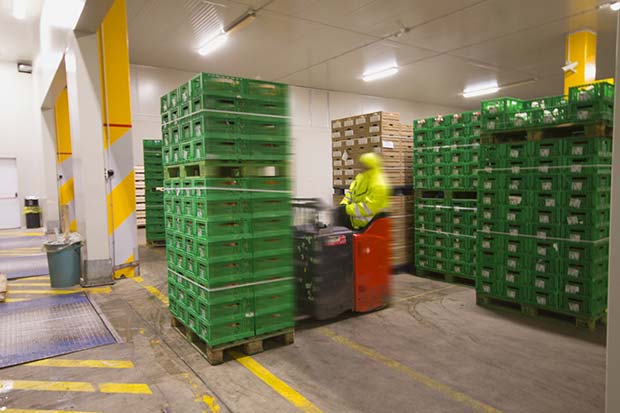Speed and punctuality are important goals in the horticultural transport industry. Efficient warehouse management may make the difference, and that starts with forklift maintenance. For this reason, the Trans Lusia Coop., with almost 30 years’ experience in horticulture both nationally and internationally, has decided to equip its new forklift fleet with NexSys batteries manufactured by EnerSys. The NexSys battery is the most advanced pure-lead solution and offers high performance without the need to refill water or change batteries. Together with energy management tools, this technology can help companies reduce costs for fleet management and maintenance significantly.
 Trans Lusia, has always prided itself on its punctuality. With headquarters based in Rovigo, Italy, the company manages a 9000 m², temperature-controlled warehouse, including 700 m² of cold storage. Trans Lusia recently acquired a new fleet of 18 Linde forklifts, equipped with Thin Plate Pure Lead (TPPL) NexSys batteries, in order to boost efficiency and productivity in its chilled department.
Trans Lusia, has always prided itself on its punctuality. With headquarters based in Rovigo, Italy, the company manages a 9000 m², temperature-controlled warehouse, including 700 m² of cold storage. Trans Lusia recently acquired a new fleet of 18 Linde forklifts, equipped with Thin Plate Pure Lead (TPPL) NexSys batteries, in order to boost efficiency and productivity in its chilled department.
The challenge: keeping batteries charged and efficient, even in cold environments
The batteries in Trans Lusia’s previous fleet deteriorated early due to lack of proper management and poor maintenance. For this reason, the company was looking for forklifts with durable batteries that are able to offer maximum efficiency for at least five consecutive years without the need for ongoing maintenance.
The first challenge was the long shifts and intense working rhythms that are often part of working in horticultural warehouses. “We work in two 12-hour shifts and with two peaks: one at night, when goods arrive and have to be unloaded, and one in the afternoon, when shipments are sent out,” explains Massimo Ferrarese, Chairman of the company. “If the forklift batteries run out easily and can’t be charged quickly, particularly at peak periods, there is a risk that deliveries may be slower and carried out with less efficiency.”
Furthermore, working rhythms did not allow sufficient time for crews to maintain batteries, which ended up being neglected. The batteries’ gradual deterioration and loss of autonomy, combined with long charging times, negatively impacted not only warehouse productivity but electricity costs.
The working environment itself posed a further challenge. This is because cold storage areas are kept at a constant temperature of 4 degrees Celsius, while the storage warehouses are kept at 12 degrees; factors that should not be underestimated when it comes to batteries. Exposure to the cold can cause the battery to deteriorate, both in terms of day-to-day autonomy and its overall lifespan. Trans Lusia therefore turned to the experienced opinion of EnerSys to overcome these issues.
The solution: fast recharging and less maintenance, even in cold storage environments
EnerSys offered a solution: the traditional NexSys battery combined with modular chargers. One of the main restrictions of traditional or gel batteries, such as those previously used by Trans Lusia, is that they cannot be partially recharged (“opportunity charging”). This meant they had to be fully recharged, requiring more time. They also needed to be replaced or recharged when reaching a DOD (Depth of Discharge) of 80 per cent.
By comparison, NexSys batteries, based on innovative TPPL technology, can be charged 40 per cent in 1 hour. Furthermore, the option of fast partial charges keeps the electrolyte at a constant temperature, protecting it from low temperatures.
Disposal of the battery charging and changing room was another advantage. As NexSys batteries have hardly any gasification, they may be recharged in the working environment, while on board a vehicle, thus simplifying functionality over several shifts. In addition, NexSys batteries are sealed, meaning they do not have to be refilled with water. Energy consumption is greatly reduced thanks to TPPL technology and the use of modular chargers.
The future is now: predictive maintenance through the IoT
Trans Lusia is using a power management solution along with NexSys batteries to further reduce maintenance costs and boost energy efficiency. Through monitors on the batteries, users are able to see key parameters such as electrolyte temperature, water levels, discharge current, charge current, balance of tension between the cells, and charge status in real time.
EnerSys is able to monitor and analyse this data and provide online reports regarding battery use and advise on how to improve efficiency.
EnerSys estimates that switching to NexSys batteries and using modular chargers together with the power management solution will allow Trans Lusia to save over 30 per cent on energy over the next five years while also reducing operational and management costs (battery replacement, filling, water charges) by over a third.
Visit Enersys at IMHX 2019 on stand 20D148.
Enersys




Comments are closed.